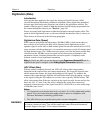
Chapter 6 Advanced Topics 69
69
Free Run {No Response}
In the Free Run {No Response} mode the
camera does not synchronize with the
experiment in any way. The shutter opens as
soon as the previous readout is complete, and
remains open for the exposure time, t
exp
. Any
External Sync signals are ignored. This mode
is useful for experiments with a constant light
source, such as a CW laser or a DC lamp.
Other experiments that can utilize this mode
are high repetition studies, where the number
of shots that occur during a single shutter
cycle is so large that it appears to be
continuous illumination.
Other experimental equipment can be
synchronized to the camera by using the
software-selectable output signal SHUTTER
{Shutter Open} or NOT SCAN {Not Reading
Out} on the Hardware Setup|Controller
Camera tab {Trigger expander } from the
LOGIC OUT connector. Shutter operation and
the NOT SCAN {Not Reading Out} output
signal are shown in Figure 29.
Figure 28. Free Run {No Response} Timing
Chart, part of the chart in Figure 36
Figure 29. Free Run {No Response} Timing Diagram
External Sync {Readout Per Trigger}
In this mode all exposures are synchronized to an external source. As shown in the flow
chart, Figure 30, this mode can be used in combination with Normal or PreOpen {Open
Before Trigger} shutter operation. In Normal Shutter {Normal} mode, the camera waits
for an External Sync pulse and then opens the shutter for the programmed exposure
period. As soon as the exposure is complete, the shutter closes and the CCD array is read
out. The shutter requires up to 8 ms or more to open completely, depending on the shutter
model.


















